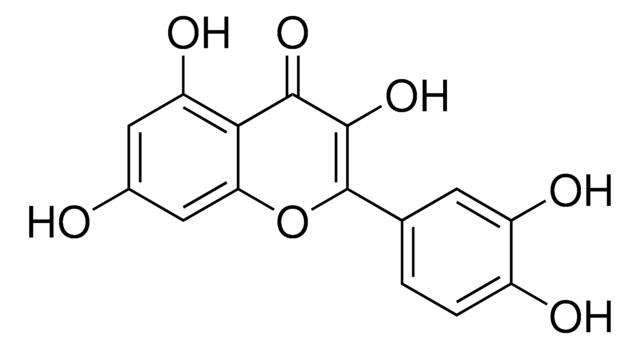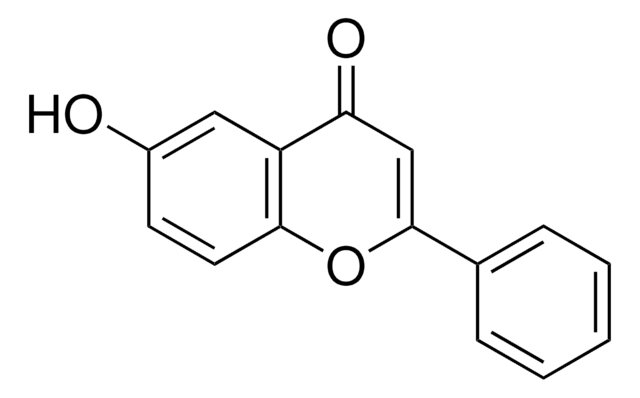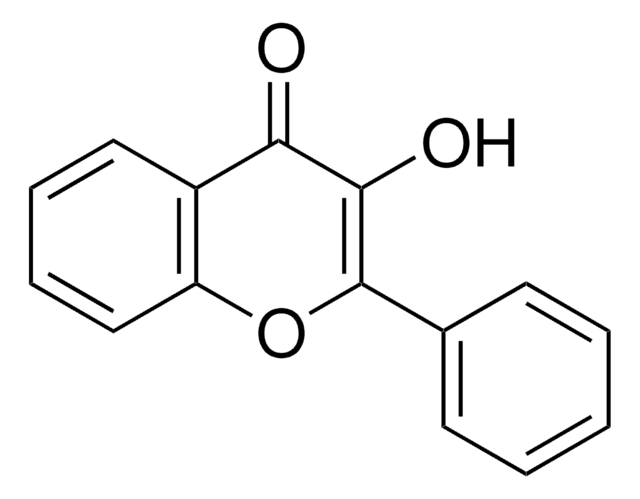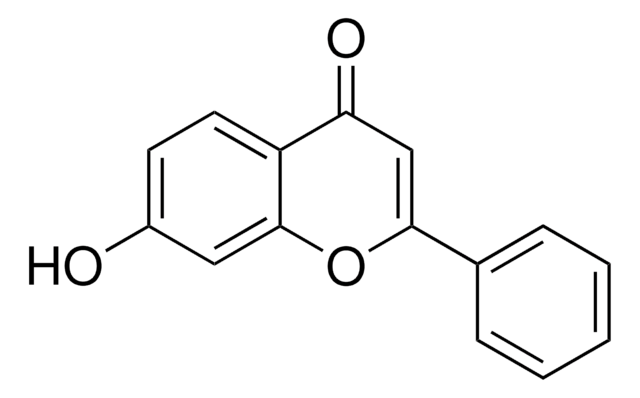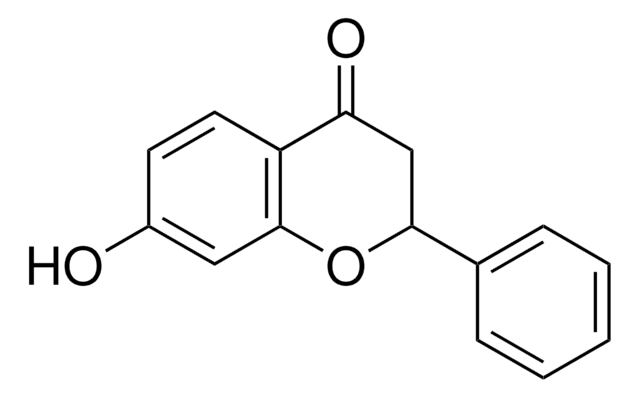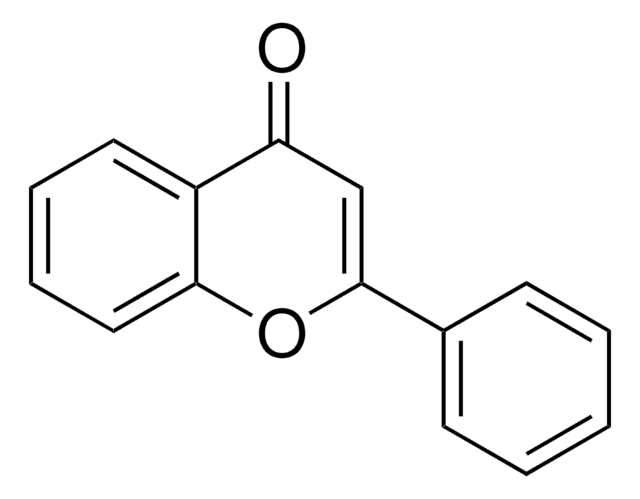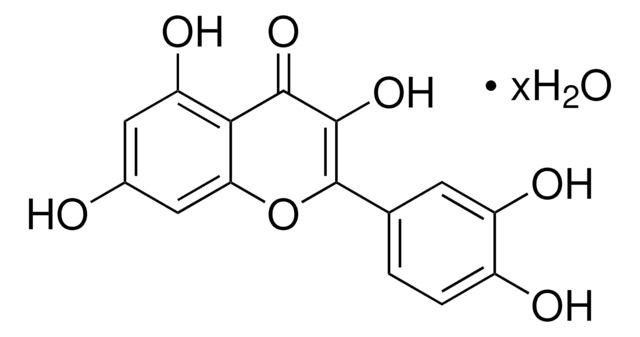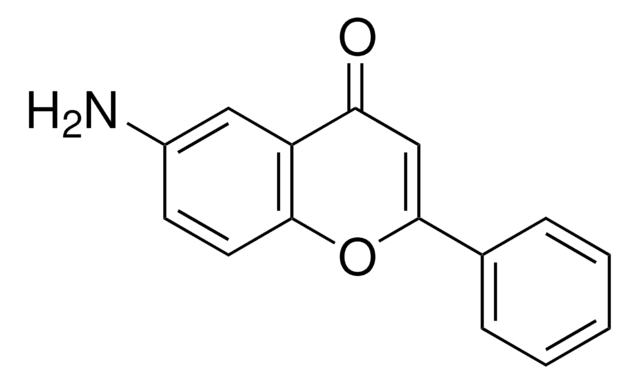H4405
5-Hydroxyflavone
≥97%
Synonym(s):
5-Hydroxy-2-phenylchromone, NSC 26745, Primuletin
Sign Into View Organizational & Contract Pricing
All Photos(2)
About This Item
Empirical Formula (Hill Notation):
C15H10O3
CAS Number:
Molecular Weight:
238.24
EC Number:
MDL number:
UNSPSC Code:
12352100
PubChem Substance ID:
NACRES:
NA.22
Recommended Products
Assay
≥97%
SMILES string
Oc1cccc2OC(=CC(=O)c12)c3ccccc3
InChI
1S/C15H10O3/c16-11-7-4-8-13-15(11)12(17)9-14(18-13)10-5-2-1-3-6-10/h1-9,16H
InChI key
IYBLVRRCNVHZQJ-UHFFFAOYSA-N
Gene Information
rat ... Gabra2(29706)
Application
Reactant involved in:
- Condensation reactions for synthesis of copper(II) complexes as bioactive molecules to combat antioxidants
- Thermal behavior studies of vanadyl complexes with flavone derivatives in terms of insulin-mimetic agents
- O-methylation with di-Me carbonate
- DFT studies on excited-state intramolecular proton transfer
Storage Class Code
11 - Combustible Solids
WGK
WGK 3
Flash Point(F)
Not applicable
Flash Point(C)
Not applicable
Personal Protective Equipment
dust mask type N95 (US), Eyeshields, Gloves
Choose from one of the most recent versions:
Already Own This Product?
Find documentation for the products that you have recently purchased in the Document Library.
Sankarlal Ash et al.
Journal of molecular modeling, 16(5), 831-839 (2009-09-18)
Potential energy (PE) curves for the intramolecular proton transfer in the ground (GSIPT) and excited (ESIPT) states of 3-hydroxy-flavone (3HF) and 5-hydroxy-flavone (5HF) were studied using DFT/B3LYP (6-31G (d,p)) and TD-DFT/B3LYP (6-31G (d,p)) level of theory respectively. Our calculations suggest
Errol G Lewars et al.
Rapid communications in mass spectrometry : RCM, 21(10), 1669-1679 (2007-04-28)
In a recent study of the collision-induced dissociation of protonated and deprotonated molecules of 3-, 5-, 6-, 7-, 2'-, 3'- and 4'-hydroxyflavone, it was observed that the ratio, gamma, of the propensities for cross-ring cleavage (CRC) to ring opening (RO)
A R Ibrahim et al.
Applied and environmental microbiology, 55(12), 3140-3142 (1989-12-01)
The conversion of 5-hydroxyflavone by various microorganisms was studied. Among them, Streptomyces fulvissimus was the sole microbe which produced a new polar metabolite from 5-hydroxyflavone in addition to 5,4-dihydoxy- and 5,3,4-trihydroxyflavone. The structure of this polar metabolite was determined to
Wimal Herath et al.
Chemical & pharmaceutical bulletin, 56(4), 418-422 (2008-04-02)
5,7-Dihydroxyflavone (chrysin) (1) when fermented with fungal cultures, Aspergillus alliaceous (ATCC 10060), Beauveria bassiana (ATCC 13144) and Absidia glauco (ATCC 22752) gave mainly 4'-hydroxychrysin (4), chrysin 7-O-beta-D-4-O-methylglucopyranoside (5) and chrysin 7-sulfate (6), respectively. Mucore ramannianus (ATCC 9628), however, transformed chrysin
C Lapouge et al.
The journal of physical chemistry. A, 109(30), 6752-6761 (2006-07-13)
The structural changes occurring with the chelation of lead(II) to 3-hydroxyflavone, 5-hydroxyflavone, and 3',4'-dihydroxyflavone have been investigated by the density functional theory (DFT) method with the B3LYP functional and the 6-31G(d,p) basis set. The two effective core potentials Lanl2dz (Los
Our team of scientists has experience in all areas of research including Life Science, Material Science, Chemical Synthesis, Chromatography, Analytical and many others.
Contact Technical Service